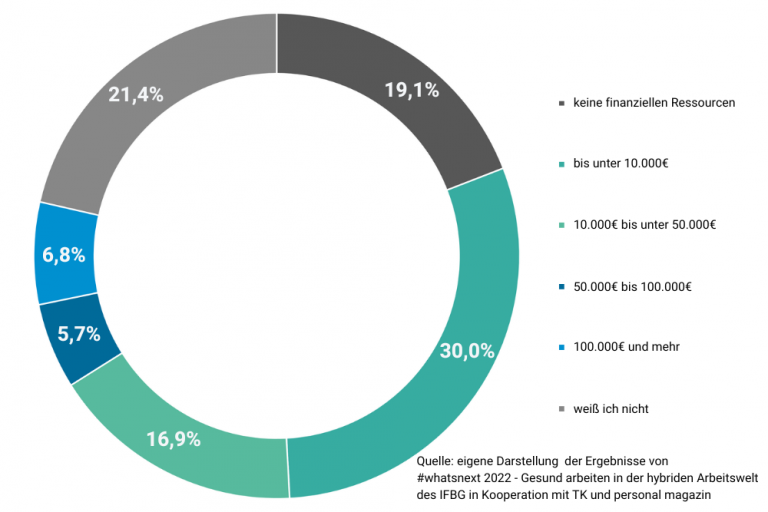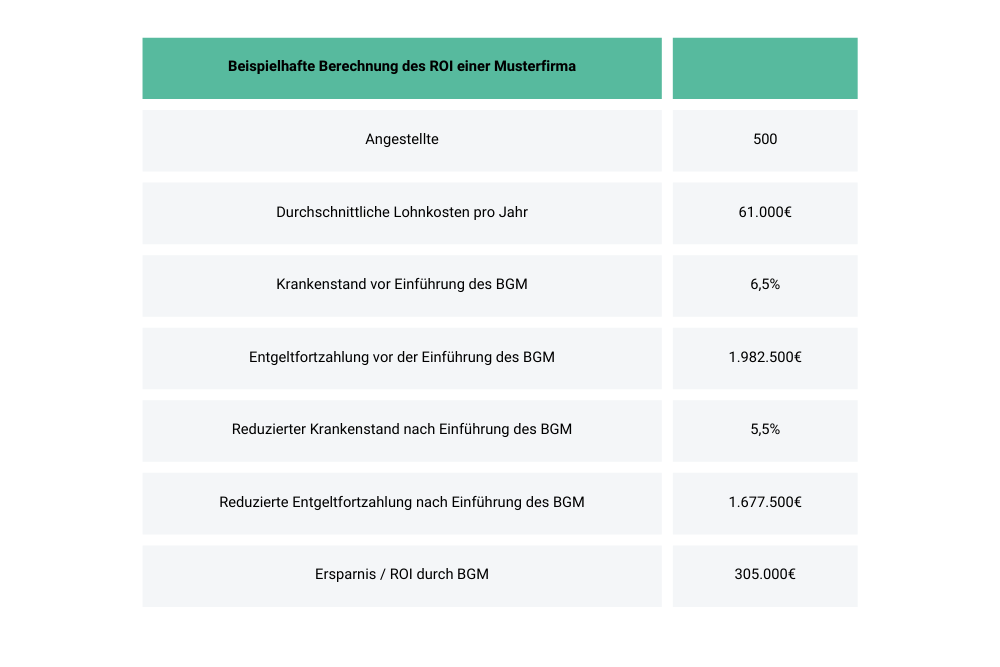
The costs, financing, funding and return on investment in the occupational health management are important aspects that companies should consider if they want to invest in the health, satisfaction and well-being of their employees.
The question of the costs and promotion of BGM measures and the assessment of ROI play a decisive role in planning, analysing, implementing and evaluating health-promoting measures in the workplace.
In this article, we will take a closer look at how companies can finance OHM, what funding opportunities exist and how the ROI of investments can be evaluated.
Although additional health programmes are a voluntary benefit for companies, there are numerous reasons why it is worth investing in the health of employees.
Investing in health has a high economic benefit for the company and can increase employee satisfaction enormously!
In general, two types of costs can be incurred in the company for the OHM:
The level of costs incurred in practice naturally depends heavily on which measures are implemented and realised in the company. However, the size of the available budget is not necessarily decisive for the success of the measures.
It is possible to develop a very successful OHM concept even if only internal measures are implemented for which no external costs are incurred.
As long as the internal measures are implemented cleverly and efficiently, the company can achieve great success without having invested a single cent in an external provider.
Which BGF measures are implemented, at best together with the preparation of the be planned as part of the company's systematic OHM strategy. The WHF measures must fit in with the overarching strategy of the OHM and be designed to achieve the company's objectives.

In this section we give you Some examples of free measuresthat can be implemented internally in the company as inspiration.
These measures can help to improve the health and well-being of employees, without incurring external costs for BGM measures. The variety of options is huge, even if you only use internal resources.

The study "#whatsnext - Working healthily in the hybrid world of work"In 2022, the Institute for Occupational Health Consulting (IFBG) analysed, among other things, how much financial resources German companies allocate to OHM/BGF each year (excluding personnel costs). At the end of 2022, around 30% of the companies surveyed that less than 10,000 euros per year for BGM and BGF are available.
You have now learnt that the success of OHM does not necessarily correlate with the amount of costs invested.
However, the involvement of external providers can offer advantages over the exclusive use of internal resources:
1. experience in BGM: A qualified service provider brings valuable experience in the field of OHM. They know best practices, have insights into industry-specific challenges and can offer customised solutions for better prevention based on their expertise.
2. special offers for employee needs: Some BGM providers have special offers and products that are tailored precisely to the needs of employees. This can range from stress management courses to healthy canteen meals. External providers can often offer a more diverse range of services that are better tailored to the individual needs of employees.
3. avoidance of internal resource expenditure: Implementing a comprehensive OHM requires time, resources and extensive expertise. It can be a lot of work to handle everything internally and new jobs may even have to be created, which in turn incurs additional costs. By working with external providers, companies can reduce the internal workload while drawing on expertise and experience.

Some specific cost points illustrate why it makes sense to involve external providers in OHM:
Strategy, process design and analysis: Developing an effective OHM strategy requires extensive analysis and expertise. External providers often have specialised experts who can carry out an objective analysis and help develop tailor-made solutions. This can help to identify potential risks at an early stage and implement cost-effective measures.
Measures that cannot usually be handled internally: Some OHM measures require specific expertise or infrastructure that is often not available internally. These include, for example, the construction of rest and relaxation rooms, the provision of ergonomic workplace equipment or advice from experts such as psychologists, physiotherapists or sports scientists. External providers can provide support here with customised solutions and a broad network of specialists to improve the effectiveness of occupational health management.
If you are prepared to budget for the introduction and implementation of a OHM, there are financial support measures available to you.
You can find detailed information on the tax benefits here: https://www.bundesgesundheitsministerium.de/themen/praevention/betriebliche-gesundheitsfoerderung/steuerliche-vorteile
The question of the return on investment in OHM is of crucial importance. The aim is to ensure that the Financial resources used effectively and bring measurable benefits for the company and its employees. Here are some key considerations for evaluating ROI in OHM:
A good ROI in OHM is demonstrated by the fact that the resources invested are effectively utilised to increase the health, satisfaction and performance of the workforce and sustainably promote the company's success. By continuously evaluating and optimising your measures, you can ensure that you achieve sustainable and measurable benefits.
Studies on ROI show that the return on investment of OHM measures can be very high. According to the Institute for Healthy Work, the Average ROI of 2.7:1. This means that for every euro invested, companies get €2.7 back. For mental health measures, it is on average even at 5:1. This ratio actually makes a discussion about investment in healthcare measures superfluous.
You can carry out your own calculation relatively simply on the basis of sickness-related absences. To do this, take a look at the sickness rate and calculate the continued remuneration for these periods. If you have made a saving since the introduction of the OHM, you can compare this with the expenses for the OHM.

If we assume that the company invests around €100,000 per year in its holistic occupational health management programme, this results in an ROI of 3:1, which means that the introduction of occupational health management is definitely worthwhile in order to achieve the Reduce sickness rates.
Of course, this is difficult to generalise, but there are reference values that allow a comparison. However, you should pay very close attention to what the individual measures really achieve.

From self-financing to external funding opportunities, there are numerous ways for companies to invest in the health of their employees.
Through careful Cost-benefit analysis and consideration of long-term effects companies can ensure that their investments in workplace health promotion bring sustainable and measurable benefits for employees and the company itself. The ROI serves as an important indicatorto evaluate the success of the investments made and make adjustments if necessary.
Whether you primarily rely on internal resources for workplace health promotion or whether you want to involve external providers depends on your goals, your budget and the demand from the workforce.